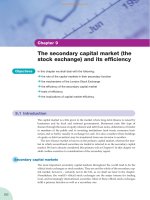Implementing financial regulation theory and practice
Bạn đang xem bản rút gọn của tài liệu. Xem và tải ngay bản đầy đủ của tài liệu tại đây (1.74 MB, 288 trang )
Implementing
Financial Regulation
Theory and Practice
Joanna Gray and Jenny Hamilton
Implementing Financial Regulation
Implementing
Financial Regulation
Theory and Practice
Joanna Gray and Jenny Hamilton
Copyright
C
2006
John Wiley & Sons Ltd, The Atrium, Southern Gate, Chichester,
West Sussex PO19 8SQ, England
Telephone
(+44) 1243 779777
Email (for orders and customer service enquiries):
Visit our Home Page on www.wiley.com
All Rights Reserved. No part of this publication may be reproduced, stored in a retrieval system
or transmitted in any form or by any means, electronic, mechanical, photocopying, recording,
scanning or otherwise, except under the terms of the Copyright, Designs and Patents Act 1988
or under the terms of a licence issued by the Copyright Licensing Agency Ltd, 90 Tottenham
Court Road, London W1T 4LP, UK, without the permission in writing of the Publisher.
Requests to the Publisher should be addressed to the Permissions Department, John Wiley &
Sons Ltd, The Atrium, Southern Gate, Chichester, West Sussex PO19 8SQ, England, or
emailed to , or faxed to (+44) 1243 770620.
Designations used by companies to distinguish their products are often claimed as trademarks.
All brand names and product names used in this book are trade names, service marks,
trademarks or registered trademarks of their respective owners. The Publisher is not associated
with any product or vendor mentioned in this book.
This publication is designed to provide accurate and authoritative information in regard to the
subject matter covered. It is sold on the understanding that the Publisher is not engaged in
rendering professional services. If professional advice or other expert assistance is required, the
services of a competent professional should be sought.
Other Wiley Editorial Offices
John Wiley & Sons Inc., 111 River Street, Hoboken, NJ 07030, USA
Jossey-Bass, 989 Market Street, San Francisco, CA 94103-1741, USA
Wiley-VCH Verlag GmbH, Boschstr. 12, D-69469 Weinheim, Germany
John Wiley & Sons Australia Ltd, 42 McDougall Street, Milton, Queensland 4064, Australia
John Wiley & Sons (Asia) Pte Ltd, 2 Clementi Loop #02-01, Jin Xing Distripark,
Singapore 129809
John Wiley & Sons Canada Ltd, 22 Worcester Road, Etobicoke, Ontario, Canada M9W 1L1
Wiley also publishes its books in a variety of electronic formats. Some content that appears in
print may not be available in electronic books.
British Library Cataloguing in Publication Data
A catalogue record for this book is available from the British Library
ISBN 13 978-0-470-86929-1 (HB)
ISBN 10 0-470-86929-1 (HB)
Typeset in 11/15pt Goudy by TechBooks, New Delhi, India
Printed and bound in Great Britain by TJ International, Padstow, Cornwall
This book is printed on acid-free paper responsibly manufactured from sustainable forestry
in which at least two trees are planted for each one used for paper production.
To Our Families
Contents
1
2
3
4
5
6
7
Preface
Acknowledgements
Regulation in context
Aligning risk and regulation: FSA’s risk-based operating
framework
Regulation within the regulated firm: legislation and rules
Senior management regulation: evidence and practice
since N2
The wider regulatory and legal context for senior
management
Regulation and the emergence of the financial citizen
An illustrated critique of meta regulation and concluding
comments
Index
ix
xiii
1
25
55
93
143
187
227
265
Preface
One of the main motivations for writing this book has been the desire
to think through the implications of some of the insights provided by
recent scholarly work that theorises about regulation and about risk,
and to try to apply and “test” these insights, albeit in an admittedly
non-scientific fashion, in the practical operating environment of the
regulation of the UK financial services sector.
Although there is much written about the application of the risk based
supervisory framework in UK financial services, there is little independent consideration of that framework, and its attendant shift in focus
from rules to risks. This book attempts to address that shortfall. Against
the background of some of this literature we consider how the regulator
has extended its reach downwards into the level of the regulated entity to impose direct and specific responsibilities on individuals within
firms, especially senior management and individual senior managers.
In so doing we analyse this trend against some of the key theoretical
literature on regulation and compliance as well as against the notion
of “responsibility” within complex organizations, and present a critique
of much of the rhetoric surrounding notions of compliance/ethical culture as well as the recent sharpening of mechanisms of management
and manager accountability within UK financial regulation. We also
present a critique of the impact of some of the ‘consumer protection’
regulation, such as information disclosure, in the light of the growing
literature on, for example, consumer decision making.
x
PREFACE
We are conscious that in attempting to apply the insights of the theoretical literature to the practice of financial regulation some might
suggest that this book is neither one thing nor the other – neither a
rigorous theoretical analysis nor a rigorous explanation of the operational detail of the regime. However, we would respond that we believe
there should be more cross-over between regulatory theorists and those
familiar with the operational detail of various regulated business sectors.
Unless scholarship has an explanatory power it is open to the classic (and
often unfair) charge that it looks inward and speaks to itself rather than
having any interest, much less relevance, to the world beyond. Attempts
to marry theory and practice are few and far between in legal scholarship,
but the value of any theory must ultimately be its ability to explain.
Inevitably we were selective in those aspects of the regulatory regime
that we have chosen to analyse. We have chosen to confine our analysis primarily to the impact of the policy and actions of the Financial
Services Authority itself, but we acknowledge that there are some significant other areas of the regulatory framework, in the broader sense,
that have the potential to impact on the downward reach of regulation – such as the Financial Ombudsman Service and which would also
benefit from analysis, but these remain for future research.
As ever with any attempt to write in an area of substantive law and
regulation that is subject to constant change and reformulation there
are parts of this work that will look out of date on the literal content
of the law and FSA Handbook once this work appears. The content
of these chapters reflects the state of play in October 2005 and so subsequent developments which would otherwise have been incorporated
into this work do not appear. These include the publication as a House
of Lords Bill in November 2005 of the Company Law Reform Bill at the
start of what is likely to be its lengthy Parliamentary progress. Chapter 2 of that Bill contains provisions which govern the general duties
of directors and provides a statutory statement thereof. No sooner had
the Company Law Reform Bill been published than the Chancellor
of the Exchequer announced, in the December 2005 Pre-Budget Report the Government’s intention to do away with the new requirement
for quoted companies to produce an Operating and Financial Review
PREFACE
xi
in which they address and report on some of the broader “stakeholder
oriented” issues beyond shareholder value that, as the discussion in
Chapter 5 points out, are indicative of a desire to effect a degree of
cultural or “mindset” change within companies. However, the reason
given by the Chancellor for this decision simply reflects that these concerns and issues will be addressed elsewhere for many companies as they
produce Business Reviews in order to comply with the EU Acccounts
Modernisation Directive (2003/51/EC).
Another development announced in that same Pre-Budget Report
was the Government’s intention to produce a Regulatory Reform Order
in order to implement those changes recommended by the N2 + 2
Review of FSMA 2000. One of those changes is to remove the need for
the FSA Board to give formal approval to all general guidance issued
by FSA, so that delegation of this function will be possible in some
circumstances, to a committee or even individual staff member at FSA.
This might be thought to go some way to meeting the concerns of
firms expressed in the most recent Financial Services Practitioner Panel
survey discussed in chapter 4 and again in the critique of the operation
of regulatory enrolment in chapter 7. However, we would argue that this
is unlikely, for the strong concerns expressed therein by firms related to
the willingness of FSA to issue guidance in the first place and are more
likely to relate to individual guidance than general.
Another important development which is likely to emerge before
publication is the FSA’s final response to its Consultation Paper 05/10.
This feedback is likely to impact on the operation of the regime of “individualised” responsibility for senior managers and other individuals
performing key functions within regulated firms discussed in chapter 3.
Some initial response was given by the FSA in its “Better Regulation
Action Plan” of 2 December 2005 but final feedback will not be given
until the position of the Approved Persons regime in Chapter V FSMA
under the implementation framework for the Markets in Financial Instruments Directive becomes clearer.
Joanna Gray and Jenny Hamilton
31 January 2006
Acknowledgements
The authors are extremely grateful for the advice and assistance and
encouragement received from colleagues within the profession and the
academic community, as well as family and friends. In particular we
would like to thank Arthur Selman who provided an extremely helpful
practical perspective and critique of parts of this book, and Gerald Rose,
for identifying additional sociological sources and perspectives. We also
want to thank those colleagues at Strathclyde University, Newcastle
and Dundee as well as colleagues from other institutions who supported
and encouraged us in this endeavour and especially those who reviewed
particular chapters and helped us clarify our thoughts, especially Donald
Nicholson, John Blackie, Iain MacNeil, and Peter Cartwright. We need
also to thank the team at John Wiley & Sons for their generous patience
and support.
Finally, to Bruce and Gary, for their tolerance and support.
1
Regulation in context
Financial services regulation has matured considerably in the past
25 years. The current regulator, the Financial Services Authority (hereafter “FSA”), has developed a sophisticated, comprehensive and potentially far-reaching regulatory tool kit through which to implement its
objectives.1 This reflects the fact that the “art” of regulation is now
understood to be far more diverse and intricate than when regulation
first began to attract academic interest. While it operates within the
statutory framework imposed by the Financial Services and Markets
Act 2000 (hereafter “FSMA”), there are three aspects of this regulatory toolkit developed by the regulator that we believe are of particular
importance and significance. These are the subject of this book, rather
than the structure of the regulatory environment for financial services,2
which needs little explanation and has been extensively described and
analysed elsewhere.3
1
See J Black, Mapping the Contours of Financial Services Regulation (Centre for Analysis
of Risk and Regulation, LSE: London, 2003).
2
This structure has undergone significant change since the 1980s – from one of little or
no regulation of different sectors within financial services industry to “self-regulation
under a statutory umbrella” – to full statutory regulation under one “super-regulator”.
3
See, for example, G McMeel and J Virgo, Financial Advice and Financial Products: Law
and Liability (Oxford University Press: Oxford, 2001); J Hamilton, Financial Services
2
IMPLEMENTING FINANCIAL REGULATION
The first aspect of central importance is the adoption by the FSA
of risk-based regulation, and the concomitant development of its riskbased operating framework for supervision. This is of fundamental significance, and provides the context within which analysis and discussion
of the two further aspects are carried out. The first of these two further
aspects is the trend towards greater regulatory incursion into the internal
business management processes and strategies of regulated firms through
regulatory tools which address the role of senior managements of firms,
and directly regulate individuals within firms, especially senior managers. The second further aspect is the change in regulatory rhetoric and
action over the last 20 years to mirror the re-drawing of the boundary between collective and personal responsibility. This has led to an increasing emphasis on financial citizenship and personal financial autonomy.
The centrality of these aspects is in stark contrast to the situation
in the early days of the precursor of the FSA, the Securities and Investment Board (hereafter “SIB”). At that time regulation was viewed
simply in terms of command and control. Its effectiveness was judged
against compliance with prescriptive and detailed rules, and regulators
in the financial services sector were left to determine their own broad
regulatory objectives.
The rise of risk
In one sense the adoption of risk as the basis of regulation by the financial
services regulator is neither particularly unique nor unusual. Discourses
around risk have now become commonplace within executive government in the UK.4 As Fisher5 has commented:
Regulation, in L Macgregor, T Prosser and C Villiers (eds) Regulation and Markets
Beyond 2000 (Ashgate: Aldershot, 2000), p 243; M Blair, L Minghella, M Taylor,
M Threpiland and G Walker, Blackstone’s Guide to the Financial Services and Markets
Act 2000 (Blackstone Press: London, 2000).
4
Although as Black identifies, risk-based regulation has two distinct meanings, one
refers to the implementation of internal risk management systems, the other refers to
risk-based regulation where sources of risk are regarded as external to the organisation –
J Black, The Emergence of Risk-based Regulation and the New Public Risk Management
in the UK, Public Law, 512–548.
5
E Fisher, The Rise of the Risk Commonwealth and the Challenge for Administrative
Law, Public Law, 2003, 455–478 at 455.
REGULATION IN CONTEXT
3
One of the central tasks of the UK executive state is now perceived to be the
handling of risk . . . The task of public decision makers is increasingly characterised in terms of the identification and assessment and management of risk and
the legitimacy of public decision-making is also being evaluated on such a basis.
Furthermore, risk has become the dominant concept across a range of
regulatory spheres from environmental protection and health and safety
to other diverse arenas such as health, penology, and child protection,6
as well as public sector management and finance. It has become the
dominant concept in the regulatory reform process itself where regulation has to be proportionate to the risks.7 As Fisher notes, in some of
these spheres a concern for risk has always been implicit, as, for example, in environmental protection, food safety and occupational health
and safety. In other regulatory spheres a focus on the concept of risk is
relatively recent. Increasingly, however, regulators are required to engage in formal risk assessment and risk management.8 It is clear now
that the language of risk has permeated most areas of executive government. This is so much so that HM Treasury’s Management of Risk:
Principles and Concepts9 states that “it can now be presumed that all
existing [government] organisations have basic risk management processes in place”10 and further that “every organisation which wants to
maximize its success in delivering its objectives needs to have a risk
management strategy, led from the very top of the organisation, which
is then implemented by managers at every level . . . and embedded in
the normal working routines and activities of the organisation”.11
6
See, e.g., J Braithwaite, The New Regulatory State and the Transformation of Criminology, in D Garland and R Sparks (eds) Criminology and Social Theory (OUP: Oxford,
2000), and P O’Malley, Risk, Uncertainty and Government (Glasshouse Press: London,
2004), M Power, The Risk Management of Everything: Rethinking the Politics of Uncertainty
(Demos: London, 2004).
7
Better Regulation Action Plan, 24 May 2005, available at and speeches/press/2005/press 50 05.cfm. See also Transforming the Regulatory Landscape – Launch of Consultation on Bill for Better Regulation, Cabinet Office, 24 July 2005.
8
E Fisher, supra, n 5.
9
Consultation Draft, May 2004 (HMSO, 2004).
10
Ibid., para 1.3.
11
Supra, n 9, para. 2.6.
4
IMPLEMENTING FINANCIAL REGULATION
As Fisher observes, however, the notion that risk is now embedded in
public decision-making is not a simple case of rebranding past practices
with new buzzwords. Instead, risk represents a new way of conceptualising what “public administration” and regulation do. She suggests it
is not simply a tool for decision-making, but in fact represents a new
way of governing, and adds that “the end result has seemingly been
a dramatic evolution in what public administration does and what it
is perceived that it should do”.12 This evolution, she believes, has a
number of fundamental implications for what is understood to be the
role and the nature of the administrative state and the role of nonlegal modes of regulating public administration, as well as how to identify good and bad public decision-making. It raises not only questions
about the meaning of risk but also questions relating to the ways it
is deployed by regulators and administrators, and its implications for
citizens.
But it is recognised that the way risk has been embedded varies across
public bodies and agencies.13 Consequently, it cannot be analysed as if
it were a uniform and unifying development across administrative and
regulatory spheres. Rather each sphere needs to be examined for its specific implications. But in the call for more site specific examination of
the embedding of risk it is important not to lose sight of the fact that this
embedding is taking place within the context of an embedding of risk
generally across a whole range of administrative and regulatory spheres.
To ignore this wider context would be to overlook more subtle and
broad-based implications of this development, and it is worth therefore
analysing why risk has become so central in administrative and regulatory spheres generally. At the same time, risk is a concept that may be
taken for granted by those involved in the everyday practices associated
with it, and requires to be unpacked before looking at it further in the
context of financial services regulation.
12
E Fisher, supra, p 2, n 5.
See, for example, C Hood, H Rothstein and R Baldwin, The Government of Risk: Understanding Risk Regulation Regimes (Oxford University Press: Oxford, 2001), P O’Malley,
supra, p 7, n 6.
13
REGULATION IN CONTEXT
5
Why risk has become central
Very different explanations are given for why risk has come to be central
across government and regulatory spheres.14 These explanations are, in
part, influenced by the different approaches to what risk is, discussed
below.
In attempting to account for the emergence of risk as a strategic organising principle in the public sector some commentators have simply
pointed towards the particular needs of government. They highlight the
need to restore confidence in the aftermath of mismanaged crises (especially responding to particular stimuli such as the collapse of the
Barings banking group and BSE), and the need to improve communication with the public, in order to better manage public expectations.15
Political scientists, however, convincingly suggest that the adoption
of the language and practices of risk reflects a deeper, more complex
process, that of “political isomorphism”.16 This is a process of policy
transmission such that bodies will adapt to or adopt governance strategies that have a common currency and will alter their practices so as
to become more like those around them. In other words, as a strategy
or operating principle risk becomes accepted and embedded in one
organisation or institution, and so it acquires a currency within other
organisations or institutions.
However, given that risk has been conceptualised and utilised in different ways across organisations and institutions, a process of policy
14
And the literature is extensive – see, for example, M Power, supra, n 6; D Vogel, The
New Politics of Risk Regulation in Europe, Centre for Analysis of Risk and Regulation
(LSE: London, 2001), and the references contained within.
15
M Power, supra, n 6.
16
P DiMaggio and W Powell, The New Institutionalism in Organisational Analysis (University of Chicago Press: Chicago, 1991). See also P Frumkin and J Galaskiewicz, Institutional Isomorphism and Public Sector Organisations, Journal of Public Administration
Research and Theory, 2004, Issue 3, 283–307, M Lodge and K Wegrich, Control over
Government: Institutional Isomorphism and Government Dynamics in Public Administration, Policy Studies Journal, 2005, Vol 33, No 2, 213, E Abrahamson, Managerial
Fads and Fashions; The Diffusion and Rejection of Innovations, Academy of Management
Review, 1991, 16, 586–612.
6
IMPLEMENTING FINANCIAL REGULATION
transmission cannot be the whole explanation.17 Other explanations,
primarily from within the socio-cultural disciplines, suggest that the
centrality of risk stems from issues connected with control, accountability, responsibility and blame in late modern society. Two prominent
theoretical perspectives that address these issues are broadly termed
“risk society” theory and “governmentality” theory. The former draws
on the work of the sociologists Beck and Giddens.18 The latter draws
on the work of the important French social thinker Foucault.19
At the risk of oversimplifying and caricaturing these important and
extremely influential perspectives, the approach of “risk society” theorists such as Giddens and Beck is one that identifies what they believe
to be broad socio-economic and political changes that have occurred
in late modern societies. Among these changes they identify a loss
of faith in institutions and authorities and a greater awareness of the
limits and uncertainties associated with science and technology. This
loss of faith, greater uncertainty and consequent anxiety about the future has arisen, they suggest, because of an increased awareness of the
17
Some suggest that in fact the politics of risk has a long genealogy in government
and that in fact what has changed is the way in which it is being deployed – see, e.g.,
P O’Malley, 2004, supra, p 27, n 13.
18
See, e.g., the work of Ulrich Beck, and Anthony Giddens: U Beck, Risk Society
(Sage: London, 1992), U Beck, Risk Society Revisited: Theory, Politics and Research
Programmes, in B Adam, U Beck and J Van Loon (eds) The Risk Society and Beyond:
Critical Issues for Social Theory (Sage: London, 2000), U Beck, The Reinvention of
Politics, in U Beck, A Giddens and S Lash, Reflexive Modernisation: Politics, Tradition
and Aesthetics in the Modern Social Order (Polity Press: Cambridge, 1994), A Giddens,
Risk Society: The Context of British Politics, in J Franklin (ed) The Politics of the Risk
Society (Cambridge: Polity Press, 1998), A Giddens, Risk and Responsibility, Modern
Law Review, 1999, 62, 1.
19
See, e.g., G Burchell, C Gordon and P Miller, The Foucault Effect: Studies in Governmentality, (Chicago University Press: Chicago, 1991); N Rose, Governing the Soul: The
Shaping of the Private Self (Routledge: London, 1990); N Rose, Powers of Freedom: Reframing Political Thought (CUP: Cambridge, 1999); M Dean, Governmentality: Power and
Rule in Modern Society (Sage: London, 1999). The Chair Foucault held at the College
de France was in “The History of Systems of Thought”. This connects with his general
concern with the way human beings are sought to be controlled. For an introduction to
his work, see P Rabinow, The Foucault Reader (Random House: London, 1984); B Smart,
Michael Foucault (revised ed) (Routledge: London, 2002).
REGULATION IN CONTEXT
7
larger scale of risks faced in the 20th and 21st centuries (the period of
“late modernity”20 ). This is encapsulated in what has been termed the
“risk society”– a society in which most risk is “manufactured”, that is,
generated by humans as part of the techno-economic development of
industrialisation, modernisation and capitalism, rather than externally
imposed by nature.
Giddens, for instance, suggests that concern with risk has become
ubiquitous because of an increasing awareness of the potential scale
of these “manufactured” risks, which are typically unseen, global and
potentially catastrophic. There is increasing awareness, too, of the contingent nature of risk assessment and management techniques. Late
modern society is not necessarily intrinsically more dangerous than
before.21 Indeed, we now live longer, have better health etc. But for
every scientific “breakthrough” there are new uncertainties and new
risks to be faced. There is now an awareness at all levels of the “inherent indeterminacies and uncertainties of risk diagnosis” associated
with manufactured risk.22 This contrasts with the position at an earlier
period (which Beck calls “simple modernity”), where there was belief
in the ability of experts to identify, measure and hence control risks,
or at least a belief that with the advancement of science they would
ultimately succeed in doing so.
In addition, attempts to try to confine and control these risks increases uncertainty and danger.23 The near collapse in 1998 of Long
Term Capital Management, an investment fund that traded in derivatives – the very instruments created to off-set modern risk – can be seen
as a quintessential example of what Beck and Giddens would call modern manufactured risk. Had it not been for the bailout encouraged by US
Federal Reserve Bank, its collapse had the potential to unravel the entire
20
Or what some would call “postmodernity”. See, for example, D Harvey, The Condition
of Postmodernity (Blackwell: Oxford, 1989).
21
Cf. Ulrich Beck – who believes society is facing potentially apocalyptic threats, see
U Beck, Risk Society (Sage: London, 1992).
22
U Beck, Risk Society Revisited: Theory, Politics and Research Programmes, in
B Adam, U Beck and J Van Loon, 2000, supra, p 219, n 18.
23
Ibid., p 206.
8
IMPLEMENTING FINANCIAL REGULATION
banking system.24 As a result, they suggest, we have entered a period of
“reflexive modernisation” which involves questioning the outcomes of
modernity, including the practices and procedures associated with industry and science.25 “Risk society” theory suggests that the preoccupation with risk in government and regulatory circles is a response to a general recognition that there are limits to the ability to know or to control
the uncertainties associated with late modernity, and to a public wanting to hold public decision-makers to account. Risk is now viewed as a
political rather than a metaphysical phenomenon.26 Giddens, who has
been a formative intellectual influence on the development of Labour
“third way” ideology, suggests that “[a] good deal of political decisionmaking is now about managing [these manufactured] risks – risks which
do not originate in the political sphere, yet have to be politically managed”.27 For the exponents of the “risk society” thesis, risk governance
is not so much associated with control but with the absence of control.
In Giddens’ phrase late modern society is a “runaway world”.28
An alternative perspective on the centrality of risk is offered by “governmentality theory”. The term “governmentality” is used to refer to
24
The study of the collapse has generated much paper and ink and different reasons put
forward for its collapse. See, e.g., F Partnoy, The Politics of Greed (Profile Books: London,
2003); M Stein, Unbounded Rationality: Risk and Organizational Narcissism at LTCM,
Human Relations, 2003, Vol 56(5), 523–540; D MacKenzie, Long-Term Capital Management and the Sociology of Arbitrage, Economy and Society, 2003, 32, 349–380;
D MacKenzie, Fear in the Markets, London Review of Books, 2000, Vol 22, No 8, accessed on-line at www.lrb.co.uk/v22/no8/mack01 .html
25
A Giddens, Risk and Responsibility, supra, p 6, n 18. Beck describes reflexive modernisation as “self-confrontation with the effects of risk society that cannot be dealt
with and assimilated in the system of industrial society”: U Beck, in U Beck, A Giddens
and S Lash, Reflexive Modernisation supra, p 6, n 18. For a discussion of the similarities and differences between Beck’s and Gidden’s concept of reflexive modernity, see
S Lash, Reflexivity and its Doubles, also in U Beck, A Giddens and S Lash, Reflexive
Modernisation.
26
D Lupton and J Tulloch, Risk is Part of Your Life; Risk Epistemologies Among a Group
of Australians, Sociology, 2002, Vol 36(2), 317–334.
27
A Giddens, Risk and Responsibility, supra, p 5, n 18.
28
A Giddens, Runaway World: How Globalization is Reshaping our Lives (Profile Books:
London, 1999).









